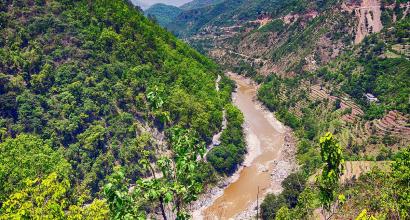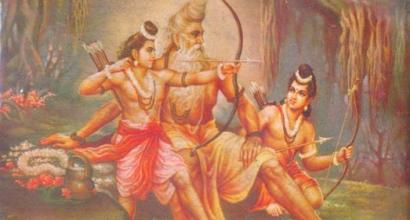The Life of Srikrishna
The fifth Amsa of the Vishnupurana is dedicated to the story of Srikrishna. Among the ten Avataras of Vishnu, the stories of Srirama and Srikrishna are renowned. Because Valmiki Maharshi’s Srimad Ramayana is exclusively reserved for Srirama’s story, it could have been the intent of the Purana authors to expand the story of Srikrishna here. There is a famous tradition that Srikrishna himself was a previous avatara of Vishnu. However, in the Vishnupurana, it is clearly mentioned in several places that Srikrishna is an aspect of Vishnu.
amśāvatāro brahmarṣe yo'yaṃ yadukulodbhavaḥ || (5.1.2)
viṣṇoraṃśe bhuvaṃ yāte
yohamamśāvatīrṇasya mukhaṃ drakṣyāmi cakriṇaḥ || (5.17.2)
bhagavad vasudevāmśo dvidhā yo'yaṃ vyavasthitaḥ || (5.18.26)
aṃśena lokāmāyataḥ prasādasumukhaḥ prabho || (5.29.25)
In the story of Srikrishna’s Avatara, there are descriptions of the conch, discus, etc., that he wears. There is also mention of him sitting on the Garuda, and several supernatural stories attributed to him. When these are viewed from the perspective of (Vishnu’s) other Avataras, it is easy to understand the reason behind the saying that Srikrishna was the most complete Avatara.
The fifth Amsa is actually a lovely poem that narrates Srikrishna’s story. There is greater abundance of poetic elements compared with Puranic elements in this section. The description of the autumn season, the sport of rāsa, separation pangs of the Gopis, the story of Kubja, abduction of the pārijāta, and the story of Usha—all these have been memorably portrayed. After the close of Srikrishna’s Avatara, Arjuna is defeated by Dasyus and goes into deep depression. He is then consoled by Vyasa Maharshi. All these have an incredible power of attraction for connoisseurs. The episode of Arjuna’s lament has been portrayed here in a far beautiful manner than in the Mahabharata. Srikrishna appears nowhere in this episode. The other noteworthy fact is that the incident involving the stealing of the clothes of the Gopikas does not figure in the Vishnupurana.
Two Contradictions
Akrūra was fully aware of Srikrishna’s greatness and was himself a great Bhakta. The manner in which such a personality behaved in the Syamantakamani episode seems rather strange. Not only is he involved in the conspiracy to murder satrājita, he secretly stashes the Syamantakamani with himself unbeknownst to Srikrishna. Thus, it appears as a contradiction that this great devotee of Srikrishna should backstab his own Lord.
Similar is the case of the great bhāgavata and the sagely person, Uddhava who was a faithful servant of the evil Kamsa.
Mention of the Kali Yuga
Normally, all Puranas contain a mention of the Kali Yuga in some form or the other. It is common to find descriptions of how in that Yuga, Adharma will perform a deadly dance. Because the mention of Kali Yuga in the Vishnupurana is contextual, it makes for highly delightful reading. When the (chronological) order of the description of the lineages reaches Mahapadmananda, the Vishnupurana says, “tataḥ prabhṛti śūdrā bhūpālā bhaviṣyanti.” This is verily meaningful. We learn that Mahapadmananda was coronated in 410 BCE. The Vishnupurana informs us that Parikshit was born 1500 years prior to that. That was the entry point of Kali. After Srikrishna completed his Avatara, Kali took firmer roots. Following this, Adharma began gaining ascendancy. In such a circumstance, the behaviour of those who wield political power is described very beautifully. Readers must definitely study this episode (4.24.123-151).
The Vishnupurana says that in the Kali Yuga, three easy features contribute to the welfare and well-being of the people. This is described as follows: in the Krta Yuga what is accomplished through penance, in the Treta Yuga what is accomplished through Yajnas, and in the Dwapara Yuga what is accomplished through a systematic worship of Bhagavan, the same is accomplished in the Kali Yuga by merely chanting the name of Hari. Thus, great Dharmas will be realized with minimal effort. Women will gain an equal share in the merits (Punya) of their husbands just by serving them with purity in thought, word and deed. Sudras will have no dietary restrictions in the Kali Yuga. He will attain the Exalted State through sincere service. Thus, in several ways, Kali Yuga engenders the attainment of auspiciousness and happiness with the barest effort. We must be grateful to the Purana authors who recognised the natural weaknesses of the mind and people’s laxity in their conviction in Dharma, and gave us such easy method to attain spiritual merit.
Spirituality
We have already described the spiritual tenets embedded in the Vishnupurana. Although it reflects the Upanishadic philosophy, we must notice the traces of the Bhāgavata tradition therein. For example,
oṃ namo vāsudevāya namaḥ saṃkarṣaṇāya ca |
pradyumnāya namastubhyamaniruddhāya te namaḥ || (5.18.58)
This verse clearly shows the conception of the Four Divisions (caturvyūha). However, the Vishnupurana says that these four Murtis including vāsudeva are different forms of the same Formless Bhagavan. We can consider this verse:
bhūtātmā cendriyātmā ca pradhānātmā tathā bhavān |
ātmā ca paramātmā ca tvamekaḥ pañcadhā sthitaḥ || (5.18.50)
The Omniscient and the Most Exalted Parameswara is an aspect of the Brahman’s Light:
paranjyotiracintyaṃ yattadaṃśaḥ parameśvaraḥ || (5.7.48)
sopyaṃśaḥ sarvabhūtasya maitreya paramātmanaḥ || (6.4.36)
Even Balarama is the Bhagavan himself. The Vishnupurana says that the Bhagavan donned two separate Avataras as Balarama and Krishna in order to regulate the world.
bhavānaham ca viśvātmannekameva ca kāraṇam |
jagatosya jagatyarthe bhedenāvām vyavasthitau || (5.9.32)
Even the Devatas worship the manifested form of the Parabrahman. Nobody has realized the ultimate tenet behind his original aspect.
bhavate yatparaṃ rūpam tanna jānāti kaścana |
avatāreśu yadrūpaṃ tadarcanti divaukasaḥ || (4.4.17)
brahmaviṣṇuśivā brahman pradhānā brahmaśaktayaḥ || (1.2.58)
We clearly understand from such verses that Vishnu is the saguṇa form of the Parabrahman. The Parabrahman which transcends speech, which is nirguṇa and which is self-complete is nominally known as Bhagavan. The verse which says this is notable:
aśabdagocarasyāpi tasya vai brahmaṇo dvijaḥ |
pūjāyāṃ bhagavacchabdaḥ kriyate hyupacārataḥ || (6.5.71)
The Knowable Parabrahman transcends name and classification, and exists as Pure Consciousness and Pure Knowledge:
na santi yatra sarveśe nāmajātyādikalpanāḥ |
sattāmātrātmake jñeye jñānātmanyātmanaḥ pare || (6.4.37)
To be continued










































